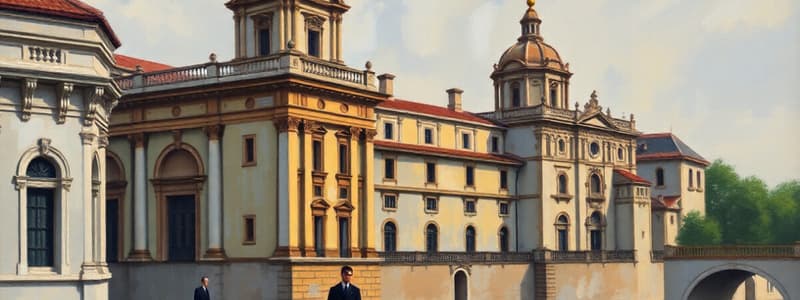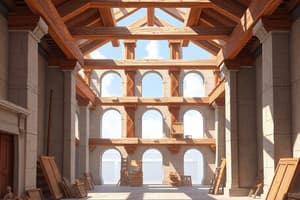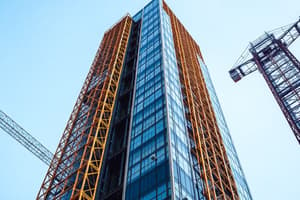Podcast
Questions and Answers
Which architectural style is characterized by a focus on simplicity and the phrase 'less is more'?
Which architectural style is characterized by a focus on simplicity and the phrase 'less is more'?
- International Style (correct)
- Gothic Architecture
- Post-and-Lintel Construction
- Doric Order
What type of construction utilizes a metal framework and is exemplified by the Bayard Building?
What type of construction utilizes a metal framework and is exemplified by the Bayard Building?
- Cast-Iron Construction
- Wood-Frame Construction
- Load-Bearing Construction
- Steel and Reinforced Concrete Construction (correct)
Which of the following structures is an example of Post-and-Lintel Construction?
Which of the following structures is an example of Post-and-Lintel Construction?
- Spruce Tree House
- Temple of Hers (correct)
- Farnsworth House
- Eiffel Tower
The flying buttress is a key feature of which architectural style?
The flying buttress is a key feature of which architectural style?
What architectural feature is primarily used in domes and barrel vaults?
What architectural feature is primarily used in domes and barrel vaults?
Which structure is known for its cantilevered design that appears to grow out of its environment?
Which structure is known for its cantilevered design that appears to grow out of its environment?
Which order in classical architecture is characterized by the use of volutes?
Which order in classical architecture is characterized by the use of volutes?
What is a primary characteristic of load-bearing construction?
What is a primary characteristic of load-bearing construction?
Which artist is associated with the concept of arbitrary color in their work?
Which artist is associated with the concept of arbitrary color in their work?
What artistic movement is represented by the piece 'Improvisation 28'?
What artistic movement is represented by the piece 'Improvisation 28'?
Which work is known for its expression of angst and erotic anxiety?
Which work is known for its expression of angst and erotic anxiety?
Which artistic approach focuses on multiple viewpoints and equivocal space?
Which artistic approach focuses on multiple viewpoints and equivocal space?
What thematic concept does Marcel Duchamp's 'Fountain' primarily address?
What thematic concept does Marcel Duchamp's 'Fountain' primarily address?
Which architectural style is exemplified by the Robie House?
Which architectural style is exemplified by the Robie House?
Which artist is known for creating works influenced by the Dada movement through photomontage?
Which artist is known for creating works influenced by the Dada movement through photomontage?
What does Piet Mondrian's 'Composition in Red, Blue, and Yellow' focus on?
What does Piet Mondrian's 'Composition in Red, Blue, and Yellow' focus on?
Flashcards
Load-Bearing Construction
Load-Bearing Construction
A building technique where walls support the weight of the structure above. The walls are thick and massive, and the spaces between them are limited.
Post-and-Lintel Construction
Post-and-Lintel Construction
This method uses vertical posts to support horizontal beams (lintels). The spaces between the posts can be wider, allowing for larger openings.
Doric Order
Doric Order
A type of classical column design characterized by its simple, sturdy appearance. It has a plain shaft with no base, a simple capital, and a plain entablature.
Ionic Order
Ionic Order
Signup and view all the flashcards
Arches
Arches
Signup and view all the flashcards
Vaults
Vaults
Signup and view all the flashcards
Cast-Iron Construction
Cast-Iron Construction
Signup and view all the flashcards
Frame Construction
Frame Construction
Signup and view all the flashcards
Fauvism
Fauvism
Signup and view all the flashcards
German Expressionism
German Expressionism
Signup and view all the flashcards
Cubism
Cubism
Signup and view all the flashcards
Dada
Dada
Signup and view all the flashcards
Surrealism
Surrealism
Signup and view all the flashcards
Futurism
Futurism
Signup and view all the flashcards
Precisionism
Precisionism
Signup and view all the flashcards
Rationalism
Rationalism
Signup and view all the flashcards
Study Notes
Architecture
- Environment and Technology:
- Pyramids of Giza and ziggurats of Sumer imitated nature. Pyramids replicated sun rays, ziggurats resembled mountains.
- Mesa Verde's Spruce Tree House and rock shelters, kivas, are examples of adapting to the environment.
- Load-Bearing Construction:
- Structures like the Lion Gate in Mycenae were built using mass.
- The Temple of Hera in Paestum showcases post-and-lintel construction.
- Post-and-Lintel Construction:
- Doric, Ionic, and Corinthian orders are different styles of columns and entablature. The Doric order has a plain capital, the Ionic is characterized by volutes, and the Corinthian order features ornate capitals.
- Arches, Vaults, and Domes:
- Different types such as round arches, barrel vaults, groin vaults, springing, pointed arches, flying buttresses, and ribbed vaulting were used.
- Gothic architecture is an example that uses particular arch forms.
- Architectural Materials:
- Cast iron was used in buildings like the Eiffel Tower.
- Wood frames were used in buildings like the Charles Bulfinch's and Harrison Gray Otis house.
- Steel & reinforced concrete were used in buildings like Louis Sullivan's Bayard Building with large windows and decorative facades. Frank Lloyd Wright's Prairie and Fallingwater Houses featured cantilevering, designs that seem to grow out of the environment. Le Corbusier and Pierre Jeanneret's Villa Savoye is another example.
Additional Architectural Styles
- International Style: Homes and buildings like the Ludwig Mies Van Der Rohe Farnsworth House embodied the "less is more" aesthetic.
- Modernism: Concepts of pure functionality and the "machine for living" as presented in examples like Le Corbusier's Villa Savoye. Example uses of rationalism in architecture are evident in Gerrit Rietveld's Schroder House.
Artwork
- Fauvism: André Derain's "Turning Road" (1905) exemplifies Fauvism. Fauvism is recognized by its arbitrary use of color.
- German Expressionism: Ernst Ludwig Kirchner's "Street, Dresden" (1908) exemplifies German Expressionism, an artistic style often characterized by subjective presentation of emotion, angst.
- War/Social Commentary: Kathe Schmidt Kollwitz's "The Outbreak" (1903) depicts a scene of war through independent expressionism.
- Cubism: Pablo Picasso's "Les Demoiselles d'Avignon" (1907), which is an example of Cubism's technique, is characterized by fragmented forms and multiple viewpoints. Georges Braque's "Houses at L'Estaque" showcases multiple viewpoints, the use of cubes, and an equivocal space.
- Analytical Cubism: exemplified by Georges Braque's "Violin and Palette" (1911), which uses fragmented forms.
- Synthetic Cubism: Georges Braque's "Bottle, Newspaper, Pipe and Glass", (1913) is an example of a synthetic cubism piece.
- Futurism: Gino Severini's "Armored Train in Action" (1915) displays a cubist artistic influence.
- Non-Objective Art: Kazimir Malevich's "Suprematist Painting" (1915) is a good example.
- Surrealism: Meret Oppenheim's "Object" (1936) is illustrative of surrealism. Constantin Brancusi's "Bird in Space" (1923) displays reductive and organic forms.
- Precisionism: Georgia O'Keeffe's "City Night" reflects Precisionism.
- Dada: Marcel Duchamp's "Fountain" (1950) represents Dada, along with his L.H.O.O.Q, and Hannah Höch's "Cut with the Kitchen Knife Through the Last Weimar Beer Belly Cultural Epoch of Germany" (1919-1920) showing irreverence through photomontage.
- Other Modern Art Styles: Motion studies, collage techniques of artists like Marcel Duchamp, Kurt Schwitters.
Studying That Suits You
Use AI to generate personalized quizzes and flashcards to suit your learning preferences.




